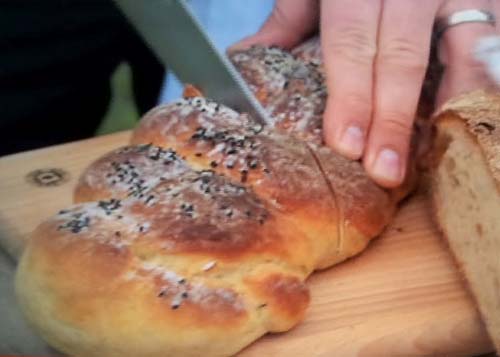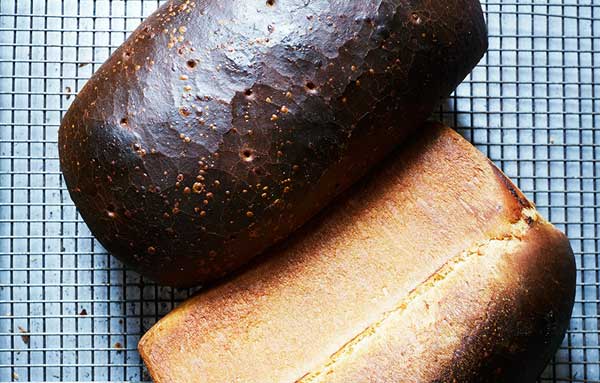Potato bread (Kartoffelbrot)
A deliciously moist, soft bread that is really is a multi-purpose bread and great for sandwiches or fried. From the Hairy Bikers.
375g/13oz potatoes (preferably Maris Piper), peeled and cut into even chunks (300g/10½oz peeled weight)
1 tsp dried fast-action yeast
1 tsp caster sugar
1 tbsp sunflower oil, plus extra for greasing
1 tsp fine sea salt
300g/10½oz strong white flour, plus extra for kneading
(or 100g/3½oz strong wholemeal flour and 200g/7oz strong white flour)
1 tsp onion seeds
You need exactly 300g/10½oz to make the bread so check the weight once they are peeled. Place the potatoes in a large saucepan and cover with cold water, bring to the boil, then reduce the heat slightly and cook for 15–20 minutes until they are tender but not falling apart.
Drain the potatoes in a colander over a bowl and reserve the cooking liquid. Return the potatoes to the pan and toss over a very low heat for 2-3 minutes until any excess liquid has evaporated.
Pour 75ml/5 tbsp of the warm cooking liquid into a large bowl and leave to cool for a few minutes. When it’s lukewarm, sprinkle in the yeast. Stir in the sugar and leave in a warm place for about 10 minutes until a light foam appears on the surface. If you’re using a mixture of wholemeal and white flour, add an extra tablespoon of the cooking liquor.
Mash the potatoes with the oil in the saucepan until they’re as smooth as possible, then stir in the yeast mixture and salt.
Mix well with a wooden spoon and gradually add the flour, a few tablespoons at a time, stirring well before adding more. When the dough becomes too stiff to stir in the flour, turn it out on to the work surface and knead the remaining flour into the dough. Don’t be tempted to add more water or the dough will become too sticky to work with.
Knead the dough for 10 minutes until soft and pliable. Place it in a lightly oiled bowl, cover loosely with lightly oiled cling film and leave to rise in a warm place for 45–60 minutes, or until well-risen and spongy to touch.
Knock back the dough with your knuckles and shape it into a rough ball. Flatten the ball on a floured surface until it is about 2cm thick, then bring the sides up to the middle to give a rustic surface to the bread. Pinch lightly to seal. Alternatively plait the bread. Sprinkle on some wholemeal flour, for additional texture, on the outside of the loaf. Place it on a lightly oiled and floured baking sheet, rough-side up, and leave to prove in a warm place for a further 30 minutes.
Preheat the oven to 220°C/Fan 200°C/Gas 7. Score the dough with a knife along the pinched join and sprinkle the top with the onion seeds. Bake the loaf in the centre of the oven for 35 minutes until well risen and crusty on top. Cool on a wire rack.

Roasted Potato Bread
From http://www.bonappetit.com/recipe/roasted-potato-bread
Makes one 8½ x 4½" loaf
Nonstick vegetable oil spray
1 teaspoon (3 g) active dry yeast
1/3 cup (80 g) potato flour
3½ cups (500 g) all-purpose flour, plus more
1 cup (180 g) buttermilk
2 tablespoons plus 1 tsp. (25 g) distilled white or apple cider vinegar
2 tablespoons (20 g) kosher salt
7 tablespoons (100 g) unsalted butter, room temperature, cut into 6 pieces
Milk (for brushing)
Lightly coat an loaf pan with nonstick spray. Place ¾ cup (160 g) cold water in the bowl of a stand mixer; sprinkle with yeast and let sit until creamy, about 5 minutes.
Meanwhile, whisk potato flour and 3½ cups (500 g) all-purpose flour in a medium bowl to remove lumps. Add flours and buttermilk to yeast mixture and mix on low speed with dough hook, increasing speed to medium as dough stiffens and comes together, about 5 minutes.
Turn out dough onto a clean surface and knead until a smooth ball forms. Transfer to a large bowl and let sit 15 minutes to relax.
Pull apart dough into several pieces and return to stand-mixer bowl. Add vinegar and salt and mix on low speed with dough hook until dough is smooth, stretchy, and no longer sticky, 5–8 minutes.
With motor running, add butter 2 pieces at a time, scraping down sides of bowl as needed and mixing until incorporated before adding more, about 4 minutes between additions. Increase speed to medium and mix until dough starts to come away from sides of bowl and forms a ball, about 5 minutes longer.
Transfer dough to a lightly floured bowl and cover with plastic wrap. Let sit at room temperature 30 minutes to relax.
Turn out dough onto a lightly floured surface. Stretch an edge up and over to the opposite side of dough. Repeat 3 times, working your way around dough. Flip dough over, return to bowl, and cover with plastic wrap. Chill until doubled in size, 18–24 hours.
Turn out dough onto a lightly floured surface and gently pat out larger air bubbles with floured hands. Fold sides of dough inward to make a 7”-long rectangle. Pat and tuck dough into a rough cylinder and place, seam side down, into prepared pan. (Make sure seam is dead center; it will help keep finished loaf from being lopsided and prevent it from splitting.)
Let dough rise until outside edges have risen just above pan, 4–6 hours.
Heat oven to 500°. Brush dough with milk. Using a wooden skewer or toothpick, very gently prick loaf 8–10 times evenly across surface, popping any larger bubbles. Place pan in oven and reduce oven temperature to 425°.
Bake until bread is deep golden brown, 50–60 minutes. Remove pan from oven, gently ease bread from pan and return to oven, placing directly on rack. Bake until sides are firm but not hard, 10–15 minutes longer.
Transfer bread to a wire rack and let cool completely before slicing (this may prove impossible, but try).
DO AHEAD: Bread can be baked 4 days ahead. Store tightly wrapped at room temperature.


